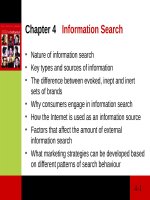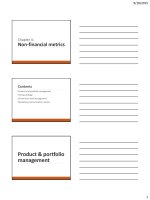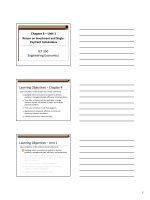Lecture Organizational behavior - Chap 4: Introducing organizational behavior
Bạn đang xem bản rút gọn của tài liệu. Xem và tải ngay bản đầy đủ của tài liệu tại đây (3.85 MB, 25 trang )
Chapter 4
Emotions, Attitudes, and Job
Satisfaction
Nothing beats feeling good
Chapter 4 Study Questions
What are emotions and moods?
How do emotions and moods influence
behavior?
What are attitudes and how do they influence
behavior?
What are the job satisfaction trends and
Issues?
Copyright © 2014 John Wiley & Sons, Inc.
What are emotions and
moods?
Affect
• Range of emotions and moods that people
experience in their life context.
Emotions are strong positive or negative feelings
directed toward something or someone.
Copyright © 2014 John Wiley & Sons,
What are emotions and
moods?
Emotional intelligence (EI)
• Ability to understand emotions in ourselves and others
and to use that understanding to manage relationships
effectively.
Copyright © 2014 John Wiley & Sons,
Figure 4.1: Four key emotional
intelligence competencies
Copyright © 2014 John Wiley & Sons,
4-5
What are emotions and
moods?
Selfconscious emotions
• Arise from internal sources (shame, guilt,
embarrassment, pride) and helps individuals regulate
their relationships with others.
Social emotions
• Arise from external sources (pity, envy, jealousy) and
information.
Copyright © 2014 John Wiley & Sons,
What are emotions and
moods?
Moods
• Generalized positive or negative feelings or
states of mind.
Copyright © 2014 John Wiley & Sons,
Figure 4.2: What are
emotions and moods?
Copyright © 2014 John Wiley & Sons,
4-8
What are emotions and
moods?
Major
Emotions
Joy
Anger
Love
Sadnes
s
Fear
Surpris
e
Copyright © 2014 John Wiley & Sons,
4-9
How do emotions and moods
influence behavior in
organizations?
Emotion and mood contagion – spillover effects
of one’s emotions and mood onto others.
Emotional labor – relates to the need to show
certain emotions in order to perform a job
well.
Emotional dissonance – emotions we actually
feel are inconsistent with the emotions we
try to project.
Copyright © 2014 John Wiley & Sons,
How do emotions and moods
influence behavior in
organizations?
Deep acting
• Trying to modify feelings to better fit the
situation.
Surface acting
• Hiding true feelings while displaying different
ones.
Copyright © 2014 John Wiley & Sons,
How do emotions and moods
influence behavior in
organizations?
Display rules
• The degree to which it is appropriate to display emotions.
Copyright © 2014 John Wiley & Sons,
Figure 4.3 Figurative Summary of
Affective Events Theory
Copyright © 2014 John Wiley & Sons,
What are attitudes and how do
they influence behavior?
Attitude
• Predisposition to respond in a positive or
negative way to someone or something
in one’s environment.
Copyright © 2014 John Wiley & Sons,
What are attitudes and how do
they influence behavior ?
Cognitive component
• Reflects underlying beliefs, opinions, knowledge, or
information a person possesses.
Affective component
• Specific feeling regarding the personal impact of the
antecedent condition evidenced in the cognitive
component.
Behavioral component
• Intention to behave in a certain way based on the
affect in one’s attitude.
Copyright © 2014 John Wiley & Sons,
Figure 4.4: What are attitudes
and how do they influence
behavior?
Copyright © 2014 John Wiley & Sons,
4-16
What are attitudes and how
do they influence behavior?
Cognitive dissonance
• Describes a state of inconsistency between an individual’s
attitudes and/or between attitudes and behavior.
Cognitive dissonance can be reduced by:
• Changing the underlying attitude.
• Changing future behavior.
• Developing new ways of explaining or rationalizing the
inconsistency.
Copyright © 2014 John Wiley & Sons,
What are attitudes and how
do they influence behavior ?
Job satisfaction
• An attitude reflecting a person’s positive and negative
feelings toward a job, co-workers, and the work
environment.
Job Involvement
• Extent to which an individual is dedicated to a job.
Copyright © 2014 John Wiley & Sons,
What are attitudes and how
do the influence behavior ?
Organizational Commitment
• Degree of loyalty an individual feels toward an
organization.
• Rational Commitment – Reflects feelings that job serves
one’s financial, developmental, and professional
interests.
• Emotional Commitment – Reflects feelings that what one
does is important, valuable and of real benefit to
others.
• Employee Engagement – A positive feeling or strong
sense of connection with the organization.
Copyright © 2014 John Wiley & Sons,
What is job satisfaction
trends and issues?
Five facets of job satisfaction:
• The work itself
• Quality of supervision
• Relationships with co-workers
• Promotion opportunities
• Rewards Pay
Copyright © 2014 John Wiley & Sons,
What is job satisfaction
trends and issues?
Withdrawal behaviors
• Dissatisfied workers are absent more
frequently, more likely to quit, or at least on
the lookout for different employment.
• Employee absenteeism and turnover can
result in
Loss of experience
Replacement costs for recruitment and
training
Physical Withdraw and Psychological
Withdrawal
Copyright © 2014 John Wiley & Sons,
What is job satisfaction
trends and issues?
Organizational Citizenship
• A willingness to “go beyond the call of
duty” or “ go the extra mile” in one’s work.
Interpersonal organizational citizenship behaviors
have individuals doing extra things that help
others.
Organizational citizenship behaviors advance the
performance of the organization as a whole.
Copyright © 2014 John Wiley & Sons,
What is job satisfaction
trends and issues?
Relationship between job satisfaction and
job performance – three theories:
• Satisfaction causes performance.
• Performance causes satisfaction.
• Rewards cause satisfaction and performance.
Copyright © 2014 John Wiley & Sons,
What is job satisfaction
trends and issues?
Theory: Performance causes satisfaction
• Satisfaction Causes Performance – increase someone’s
work performance, make them happy.
OR
• Performance Causes Satisfaction – The higher levels of
lasting satisfaction come from high levels of job
performance.
Copyright © 2014 John Wiley & Sons,
Figure 4.5 Simplified Porter-Lawler
model of the performance
satisfaction relationship?
Copyright © 2014 John Wiley & Sons,









